Laboratory of Physics of Magnetic Phenomena

The Laboratory Staff
Main Publications
Research focus
Technology for ultra-high vacuum and in situ characterization of magnetic nanostructures
(SN Varnakov, N. Kosyrev, AE Khudyakov, EV Yakovleva)
- The method of molecular-beam epitaxy is used to prepare magnetic nanostructure Fe / Si with layers thicknesses of 1.5 nm. We find conditions for the formation of iron silicides, the parameters of the diffusion of iron and silicon in the interface. Magnetooptical Kerr effect spectra measurement methods with spectral ellipsometry were developed for in situ analysis of the optical and magnetic properties of nanostructures. (Varnakov et al 2007 Solid State; Varnakov etal, J.Appl.Phys.2008; Volkov etal, J.Appl.Phys.2011; Kosyrev et al, JETP Lett 2008).
Optical and magneto-optical studies of magnetic materials
(IS Edelman, A. Malahovskiy, VN Zabluda, RD Ivantsov, AE Sokolov, O. Ivanova, AL Sukhachev)
• Transparent ferromagnets with magnetic nanoparticles implanted in the insulating glass were obtained and studied (Edelman etal, Physica E 2010; Ignatchenko etal, Phys. Rev. B 2010)
• Experimentally investigated range of electric, magnetic and optical properties of single crystals ferroborates FeBO3, VBO3, GdFe3 (BO3) 4, NdFe3 (BO3) 4 and ludwigites single crystals based on oxides of Co, Fe. Spectral and temperature dependence of f-f crystal field excitations have been measured. We have experimentally observed the virtual the electronic states in FeBO3 predicted by many-electron model of strongly correlated electrons. Spectra of charge-transfer and Mott-Hubbard excitations have been studied by RIXS measurements in APS,ANL synchrotron (Ovchinnikov et al, JETP Lett 2009; Bartolom'e etal, Phys. Rev. B 2011; Malakhovskii etal., Optical Materials 2009; Malakhovskii etal., J. Alloys Comp. 2009, Kim etal, Phys.rev.B 2011)
Transport and magnetic studies of magnetic materials
(NB Ivanova, NV Kazak, VV Rudenko)
• Theoretically predicted and experimentally studied spin crossover in ferroborates at high pressures. A new mechanism of metal-insulator transition induced by the weakening of the strong correlations due to spin-crossover at high pressures was proposed. (Ovchinnikov, J.Phys. Cond. Mat. 2005; Ovchinnikov, JMMM 2006; Ovchinnikov JETP 2008, Kazak et al, 2009 JETP ; Ding etal, Phys. Rev. Lett 2008; Gavriliuk etal, Phys. Rev. B 2008; Ivanova etal, UFN 2009; Lyubutin etal, Phys. Rev. B 2009; Ovchinnikov, JETP Lett 2011)
The theory of strongly correlated electron systems
(SG Ovchinnikov, VA Gavrichkov, MM Korshunov, E. Shneider)
- The LDA+GTB method for calculating the electronic structure of strongly correlated systems, contains no adjustable parameters has been developed (Korshunov et al 2004 JETP; Korshunov etal, Phys. Rev. B 2005; Ovchinnikov etal, "LDA + GTB method for band structure calculations in the strongly correlated materials ". Chapter in the book" Theoretical Methods for strongly Correlated systems ", Springer Series in Solid-State Sciences. Springer-Verlag Berlin Heidelberg, 2012).
- The electronic structure and Fermi surface of hole- and electron-doped cuprates high-temperature superconductors with different doping concentrations have been calculated by LDA + GTB. It is shown that there are two quantum phase transitions with Fermi surface reconstruction between the weakly doped pseudogap and overdoped normal Fermi liquid state (Korshunov etal, Eur. J. Phys. B 2007; Makarov, JETP Lett et al, 2009; Ovchinnikov et al, JETP 2009; Korshunov etal, J . Phys. Cond. Mat., 2010).
- The theory of superconductivity in the spirit of the BCS in the regime of strong electron correlations has been developed. It is shown that the phonon and magnetic mechanisms give contributions of the same order to the critical temperature. We obtain the correct concentration dependence of the isotope effect with a minimum at optimum doping (Schneider et al, JETP, 2009).
- The electronic structure of manganites and cobaltites have been calculated by LDA+GTB method, taking into account the strong correlations to study the mechanisms of electronic and magnetic transitions (Ovchinnikov et al, JETP 2007, Orlov et al, ibid, 2009; Ovchinnikov et al, ibid 2011, Ivanova et al, UFN, 2009; Ovchinnikov et al, JETP Lett 2010)
Theoretical modeling of nanostructures: carbon and non-carbon nanoparticles, nanotubes, biological molecules
(AS Fedorov, PV Avramov, FN Tomilin)
• It is shown that strong correlations in nanoparticles may provide an anomalous red shift of the absorption edge with decreasing size. The anomalous quantum confinement in silicon nanowires and nanodots is investigated (Ovchinnikov et al, Physics Solid State, 2007; Ovchinnikov, Izvestiya RAN 2008; Sorokin etal, Phys. Rev. B 2008; Sorokin etal, J. Phys. Chem. In 2008; Avramov etal, J. Appl. Phys. 2008)
• Calculation of crystal and electronic structure of β-FeSi2 nanolayers revealed restructuring of the surface layers and their metallization. The possibility of epitaxial growth of β-FeSi2 on the surface of single crystal Si (100) is shown (Fedorov et al, JETP Lett., 2012).
• Ab initio calculations of clusters modeling the protein molecule obelin were carried out. Based on these calculations the molecular mechanism of luminescence in these proteins was clarified. Also we have calculated the electronic structure and optical absorption spectra of molecules of pheromones and their stability to the interaction with components of air (Tomilin et al, Biofizika 2009; Tomilin et al Biofizika 2011; Tomilin etal, Luminescence 2010; Antipina et al monograph "Bioluminescence of photoprotein obelin . Quantum description "2010, Saarbrucken: LAP Lambert Academic Publishing; Ovchinnikov et al, JETP Lett 2010).

Recent advances
1. The technology of thermal evaporation of nanostructures Fe/Si with controlled thickness and composition of the layers in situ by electron diffraction, electron spectroscopy, ellipsometry. Designed and built the original home-made analytical and technological complex "magnitoellipsometr" to carry our thermal evaporation in ultra-high vacuum and in situ spectroscopic ellipsometry study and Kerr magnetometry.
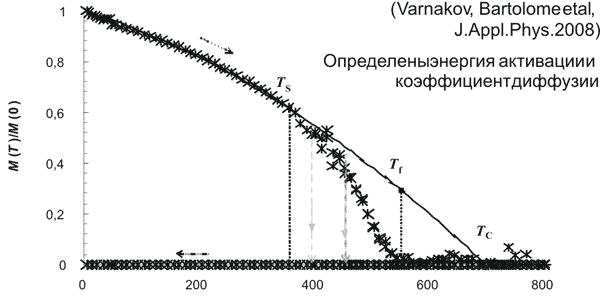
Fig.1. A solid-phase irreversible synthesis parameter extraction of silicide interface Fe / Si by the SQUID magnetization measurements of structures Fe / Si at high temperatures
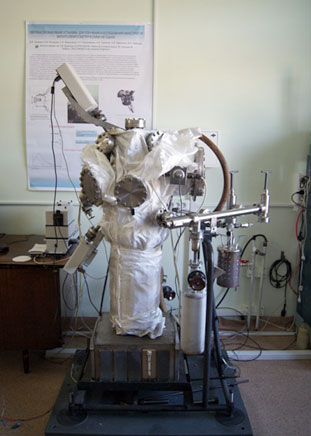 Fig. 2. Home-made spectral magnitoellipsometer. 2. As a result of a comprehensive experimental study of the structure (Fig. 3), magnetic and magneto-optical (Fig. 4) properties of iron nanoparticles formed in glasses doped with transition and rare earth elements, recommendations are given for the development of magneto-optical elements on the basis of glasses for the practically important spectral region 1, 0-1.5 microns (transparent permanent magnets).
Fig. 2. Home-made spectral magnitoellipsometer. 2. As a result of a comprehensive experimental study of the structure (Fig. 3), magnetic and magneto-optical (Fig. 4) properties of iron nanoparticles formed in glasses doped with transition and rare earth elements, recommendations are given for the development of magneto-optical elements on the basis of glasses for the practically important spectral region 1, 0-1.5 microns (transparent permanent magnets).
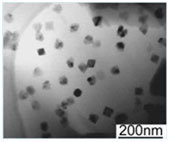
Fig. 3. TEM pictures of particles in the glass doped with Fe2O3 and MnO.
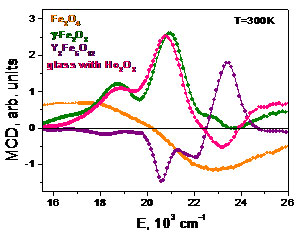
Fig. 4. MCD spectra of iron oxides and glasses doped with
Fe2O3 and Ho2O3
3. A station for measurements of magnetic circular and linear dichroism, as well as for studies of magnetic X-ray reflectometry (3-30 keV, the temperature range 4-350 K) has been developed and is under construction in the synchrotron Research Center "Kurchatov Institute". The optical and magneto-optical properties of glasses and crystals, and alumoborates and ferrobo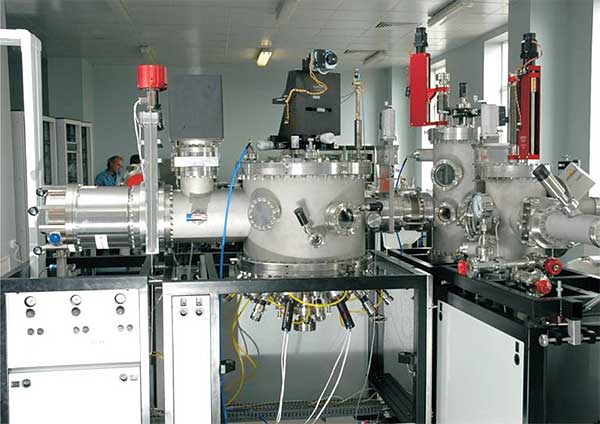 rates containing rare earth elements.
rates containing rare earth elements.
It was found that the t dependence of the magneto-optical activity (MOA) electronic transitions within the 4f shell (f-f transitions) may be very different from the Curie-Wess law. It is shown that the MOA for f-f transitions can contain several deposits of various size and sign of the allowed transitions in which the forbidden transition borrows intensity. The ratio of these contributions depends on the temperature.
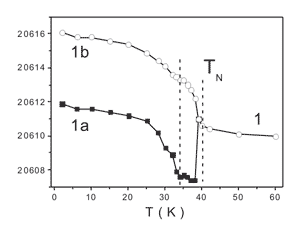
In the study of the absorption spectra of crystals and alumoborates and ferroborates we have found that the temperature behavior of the parameters of some ff transitions reveals features that are missing in the temperature behavior of the ground state. For example, in TbFe3(BO3)4 an abrupt splitting of one of the absorption lines is revealed in the Neel temperature (Fig. 5). This phenomenon has been proposed to explain the change in the equilibrium configuration of the local environment of rare-earth ion in the electronic transition.
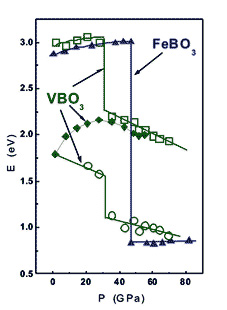
4. The interrelation of changes in magnetic, transport and optical properties of a number of magnetically Mott insulators, including high pressure in a family of single-crystal boroxides: calcite MeBO3 (Me = Fe, Cr, V), hantite GdFe3(BO3)4, ludwigites Co3-xFexO2BO3. A many-electron theory of spin crossover at high pressures in the Mott insulators was developed.
Fig. 6. Change the absorption edge and the main lines in the optical absorption VBO3 and FeBO3 under pressure.
A generalized tight-binding method for the LDA + GTB band structure calculation of systems with strong electron correlations is developed. For the cuprates La2-xSrxCuO4 a sequence of quantum phase transitions by doping an insulator to a normal Fermi liquid was found (Fig. 7), and in the mean-field theory of the superconductivity magnetic and phonon mechanisms of pairing are found to be one order of magnitude. For manganites La1-xCaxMnO3 at optimal doping x ~ 0.3 it is shown that the ferromagnetic phase is a magnetic halfmetal with a 100% spin polarization of carriers. For LaCoO3 LDA + GTB calculations explain the spin transition at T = 150 K in the temperature dependence of the susceptibility and the gradual metallization at high temperatures T = 600 K, and predicted a large magnetoresistance and the transition to the metallic state in high magnetic fields.

Fig. 7. Changes in the topology of the Fermi surface of La2-xSrxCuO4 with increasing doping concentration leads to two quantum Lifshitz phase transitions.
5. On the basis of quantum chemical calculations in the ground and excited states the structure and mechanism of the fluorescence of the active site of protein obelin have been obtained (Fig.8), the role of electron correlations in the formation of structure is revealed.
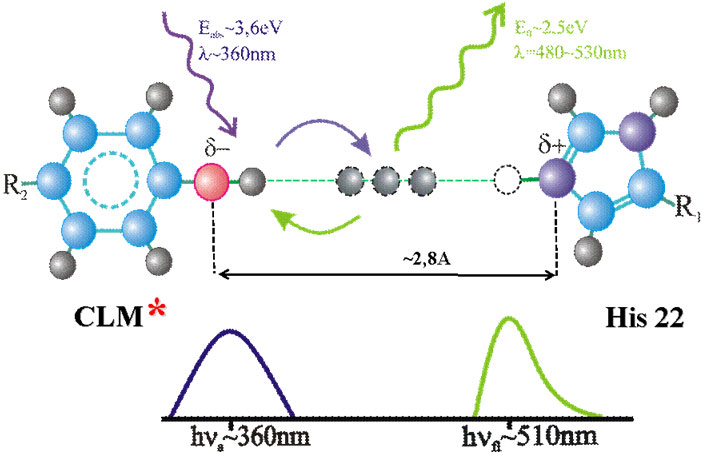
Fig. 8. The study of proton transfer in the fluorescence of the protein obelin
6. The correlation between magnetic properties and morphology of magnetic nanoparticles in the two systems of nano-structured objects: three-dimensional borate glasses doped with assemblies of nanoparticles of iron and rare earth elements, and planar assemblies of nanoparticles of magnetic metals Ni and Co, synthesized by ion implantation in the surface region of silica glass was obtained. The results are needed to provide feedback technology - material properties and to develop effective new magneto-optical control of light beams.
7. We continue to study the temperature dependence of magneto-optical and magnetic properties of magnetic hantite structure and, in particular, crystals DyFe3(BO3)4 and Nd0.5Gd0.5Fe3(BO3)4. Among the most interesting results that a hysteresis in the magnetization reversal of the antiferromagnetic crystal Nd0.5Gd0.5Fe3 (BO3) 4 can be noted. Hysteresis, and hence the domains are at a temperature below 11 K (TN = 32 K). At the same temperature there is a kink in the temperature dependence of susceptibility in small fields. In the fields >3.5 kGs, when domains disappear, and the singularity disappears in the temperature dependence, indicating a significant effect of domain walls in magnetic properties of the crystal.
8. In the study of the formation of stable iron silicides at the interface of nanostructures (Fe / Si) 3 by conversion electron Mossbauer spectroscopy, it was found that at room temperature, the depth of interdiffusion of iron and silicon is less than 4.7 nm. Annealing the structure at 600 K leads to partial interdiffusion of elements, and annealing to 800 K leads to a complete diffusion layers of iron and silicon with the formation of the equilibrium silicide FeSi.
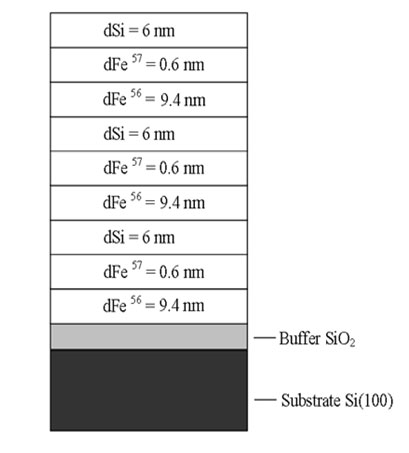
9. The magnetic and transport properties of high-quality single crystals ludwigites Co3-xFexBO5. A field and temperature dependence of the static magnetization and dynamic susceptibility at different orientations of the external magnetic field relative to the crystallographic axes was measured. Static measurements are consistent with those of the Mossbauer effect and X-ray absorption spectra of k-edges of Co and Fe, obtained using synchrotron radiation.
10. 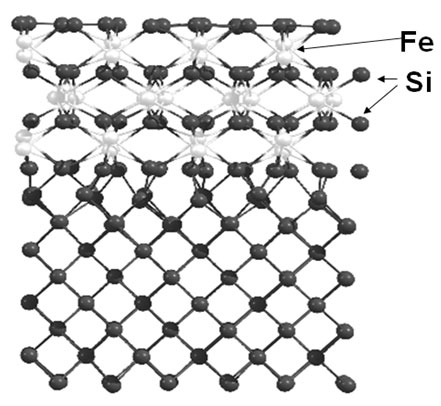 Within the formalism of density functional (GGA approximation) atomic, electronic and magnetic structures of some nanomaterials are studied, including those with vacancies: graphene, silicon nanosticks, interfaces Fe/Si, and β-FeSi2/Si, planar compounds of BN and SiC. A new approach for the calculation of impurity diffusion in the amorphous structure and calculated the diffusion coefficient of lithium in the crystalline and amorphous silicon at various temperatures is developed. Quantum-chemical calculations to evaluate the possible interactions of pheromone molecules with the substances in forest air were carried out.
Within the formalism of density functional (GGA approximation) atomic, electronic and magnetic structures of some nanomaterials are studied, including those with vacancies: graphene, silicon nanosticks, interfaces Fe/Si, and β-FeSi2/Si, planar compounds of BN and SiC. A new approach for the calculation of impurity diffusion in the amorphous structure and calculated the diffusion coefficient of lithium in the crystalline and amorphous silicon at various temperatures is developed. Quantum-chemical calculations to evaluate the possible interactions of pheromone molecules with the substances in forest air were carried out.
11. In the framework of a realistic description of the electronic structure of ferropniktides the effect of the spin-orbital interaction on the symmetry properties of the superconducting state is investigated.
12. Electron microscopy in situ investigations of solid-phase synthesis and atomic ordering in two-layer nanofilms Cu / Au with atomic ratio of Cu: Au = 3:1 is performed. The solid-phase synthesis begins at a temperature of 170 º C. At a temperature of 280 º C in the film the atomic structure of disordered Cu3Au (space group Fm-3m, with a lattice parameter a = 3.76 ± 0.01 Å) is formed. Annealing for 1 hour at 380 º C leads to the formation of the entire volume of the film atomic-ordered superstructure Cu3AuI (type L12), space group Pm-3m, with a lattice parameter a = 3.76 ± 0.01 Å.
13. Nanostructured composite powders of metal-metal and metal-insulator are obtained by chemical vapor deposition and their magnetic properties are investigated. A solid-phase synthesis and study of film MnGe, MnGa, FeMn, and CoPd - materials that are promising for spintronics and microelectronics. Experimental study of magnetic microstructure parameters and the magnitude of the magnetic anisotropy energy is localized at the micro and nano-scale in ferromagnetic nanocrystalline and amorphous materials, as well as in nanocomposites "ferromagnet-insulator" with a different spatial distribution of nanophases. Studied the optical spectra of the spin waves in sandwiches, as well as the dispersion characteristics of the acoustic spin waves in the Bragg wave vector in the one-magnon crystals.
The basic methods and technology research
The technology of thermal evaporation of nanostructures in ultrahigh vacuum, the methods of transport, and magneto-optical ellipsometry measurements, the methods of X-ray spectroscopy and magneto-optics with synchrotron sources. Methods of calculation of nanostructures and clusters from first principles, the author's LDA + GTB method for the calculation of strongly correlated electron systems.
Experimental research equipment
Setting MBE "Angara", modified for the deposition of magnetic nanomaterials with ellipometric in situ monitoring of thickness and optical Kerr effect.
Spectroscopic ellipsometry, "Ellipse-1891."
Homemade UHV technology and research complex "Magnitoellipsometr." The magneto-optical cryostat with a spectrophotometer and the magnetic field to 4.2 T spectrometers to measure the magneto-optical Faraday effect, magnetic circular and linear dichroism.
Development
Technology for creating transparent permanent magnets based on glasses with the addition of magnetic nanoparticles. Methods magnitoellipsometry for in situ and ex situ measurements.
UHV technology and research complex "Magnitoellipsometer."
